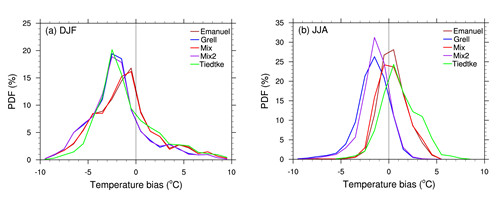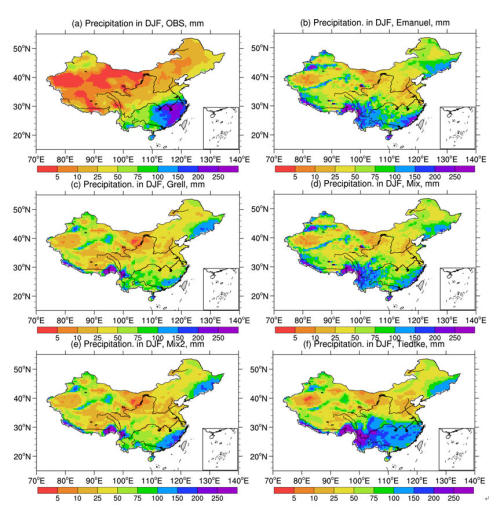The Best Convection Scheme for Regional Climate Modeling over China
Date:2016-04-27
The convective scheme is a key process in controlling the performance of climate models. China is located in the East Asian monsoon area, characterized by complicated topography and climate types, meaning that identifying the “best” convective scheme is widely considered as the most important aspect of regional climate simulation over this area (Liu and Ding 2001; Xiong and Fu 2006; Zou and Zhou 2011).
To find out the best scheme, in a recent study published in Atmospheric and Oceanic Science Letters, Dr. GAO Xuejie from Institute of Atmospheric Physics/CAS worked with scientists from National Climate Center (China) and the Abdus Salam International Centre for Theoretical Physics (ICTP, Italy) and used the latest version of the ICTP’ regional climate model, RegCM4. Compared with previous versions, one of the most important improvements in the model physics is the introduction of the Community Land Model (CLM) as an option to describe the land surface processes.
Previous studies have shown that the model performs well when using BATS with Grell over the East Asia region (e.g., Gao et al. 2012). But how does the model perform when using CLM (RegCM4-CLM)? To answer this question, scientists conducted a series of 1-yr long simulations using different convection schemes: (1) Emanuel; (2) Grell; (3) Emanuel over land and Grell over ocean (Mix); (4) Grell over land and Emanuel over ocean (Mix2); and (5) Tiedtke (TDK).
Through comparison between the simulations and observation of mean temperature in winter and summer, a dominant cold bias in DJF (December–January–February) was evident under the different convective schemes, with Emanuel and Mix showing lower magnitudes of bias compared to the others. For JJA (June–July–August), a large warm bias was found for TDK, and a cold bias for Grell and Mix2. A normal mode type distribution of bias was apparent for the Emanuel and Mix experiments, indicative of relatively better performance (Figure 1). Thus, the Emanuel scheme was confirmed as the “best” with respect to temperature simulation.

Figure 1. PDF distributions (%) of temperature bias in (a) DJF and (b) JJA, over China, derived from the model simulations using different convection schemes (land only; units: °C). (Gao et al., 2016)
The simulated precipitation amounts in winter in general captured the observed precipitation pattern. However, substantial overestimation by up to a few factors was found over most of the northern areas. Conversely, the model underestimated the precipitation center in the southeast, both in magnitude and spread, except when employing TDK (Figure 2).

Figure 2. The (a) observed and (b–f) simulated mean precipitation in DJF, 1999–2000, over China (land only; units: mm): (b) Emanuel; (c) Grell; (d) Mix; (e) Mix2; (f) TDK. (Gao et al., 2016)
For summer, the pattern was in general simulated well by the model using the different convection schemes. A wetter than observed precipitation pattern in northern China was found when using Emanuel and Mix, while the model produced results that were too dry when using the Grell scheme. The TDK simulation showed considerable overestimation along the southern coast and over southwestern China, but underestimation in the northern part of the region (Figure 3).

Figure 3. The (a) observed and (b–f) simulated mean precipitation in JJA, 1999–2000, over China (land only; units: mm): (b) Emanuel; (c) Grell; (d) Mix; (e) Mix2; (f) TDK. (Gao et al., 2016)
Considering the good performance in the temperature simulation when employing Emanuel, the scientists concluded it to be the “best” convection scheme of RegCM4-CLM over the region. Therefore, for future long-term climate change projections, the best choice of convection scheme when using RegCM4-CLM over East Asia is Emanuel.
References
Liu, Y. M., and Y. H. Ding, 2001. "Modified mass flux cumulus parameterization scheme and its simulation experiment, Part I: Mass flux scheme and its simulation of the flooding in 1991." Acta Meteorologica Sinica 59(1): 1–14.
Xiong, Z., and C. B. Fu, 2006. "Impact of convective parameterization on RIEMS simulation of summer precipitation." Climatic and Environmental Research 11(3): 387–394.
Zou, L.W., and T. J. Zhou, 2011. "Sensitivity of a regional ocean-atmosphere coupled model to convection parameterization over western North Pacific." Journal of Geophysical Research-Atmosphere 116, D18106.
Gao, X. J., Y. Shi, D. F. Zhang, J. Wu, F. Giorgi, Z. M. Ji, and Y. G. Wang, 2012. "Uncertainties of monsoon precipitation projection over China: results from two high resolution RCM simulations." Climate Research 52: 213–226.
Gao, X. J., Y. Shi, and F. Giorgi, 2016. "Comparison of convective parameterizations in RegCM4 experiments over China with CLM as the land surface model." Atmospheric and Oceanic Science Letters, doi:10.1080/16742834.2016.1172938.
Contact: GAO Xuejie, gaoxuejie@mail.iap.ac.cn
